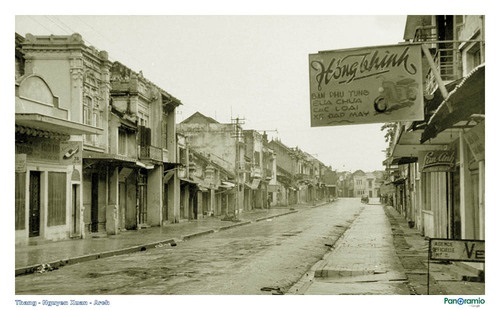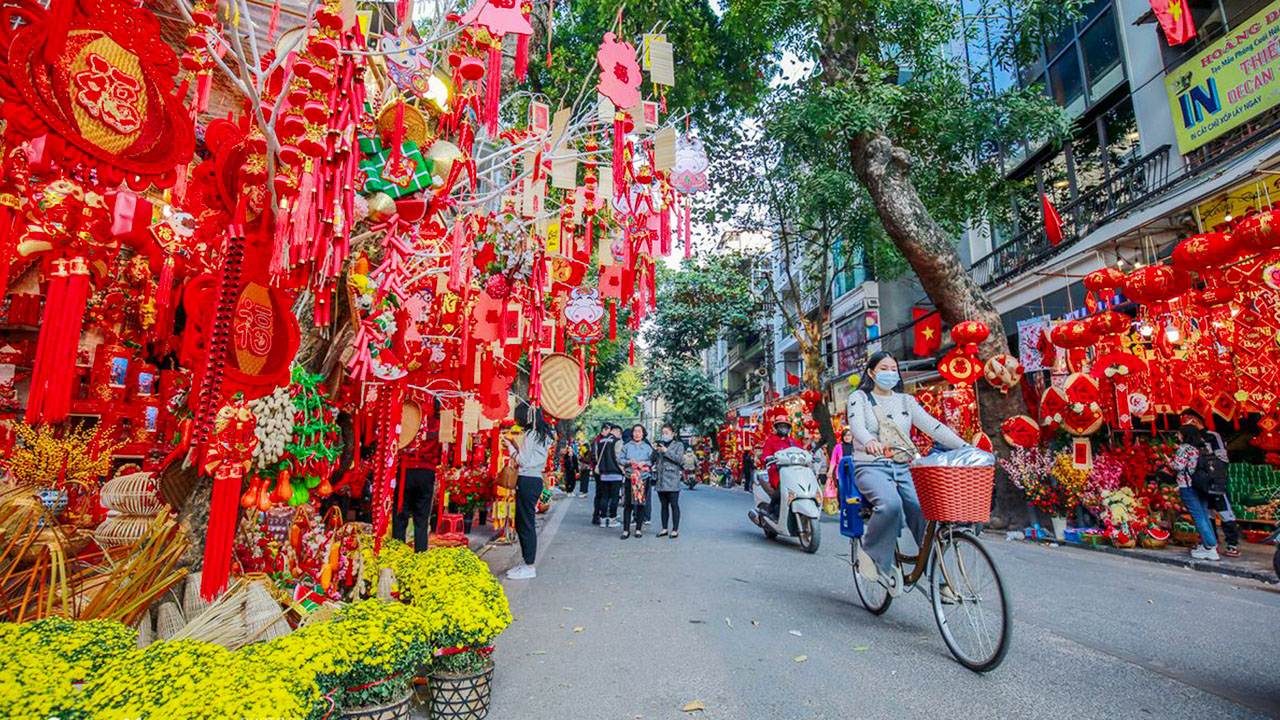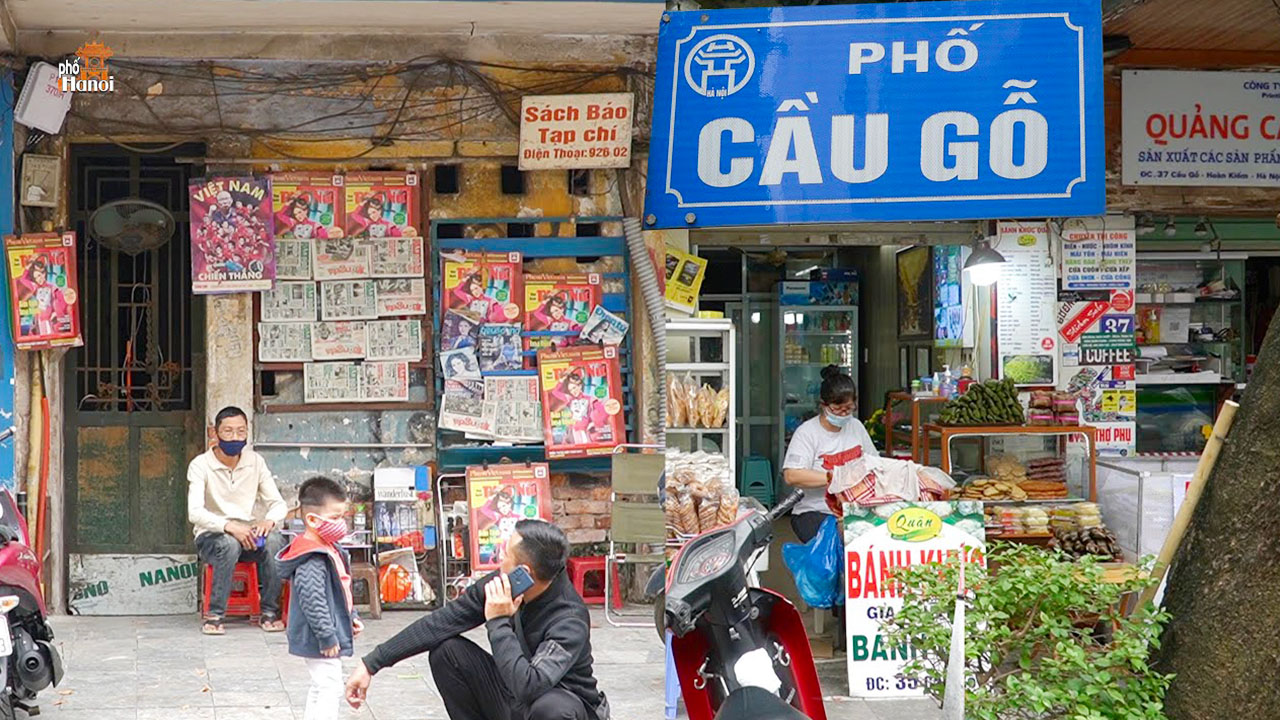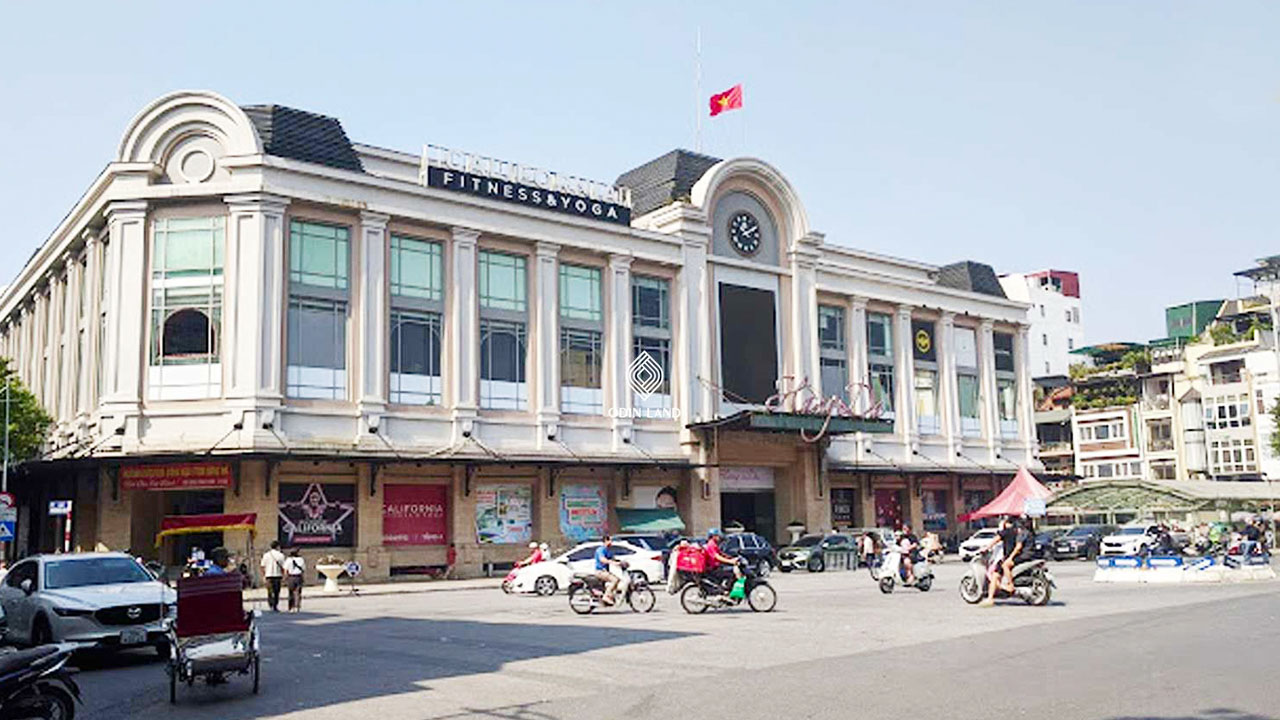Cau Go Street, or “Wooden Bridge” in English, is situated in the lively Old Quarter of Hanoi, Vietnam, renowned for its vibrant history and cultural significance. Nestled near the picturesque Hoan Kiem Lake, this street captures the essence of Hanoi’s past and present, drawing visitors into a tapestry of rich history, unique architecture, and bustling modernity. Historically significant as one of the city’s original thoroughfares, Cau Go Street was once the location of a wooden bridge that linked Thai Cuc Lake and the Lake of the Restored Sword, facilitating trade and movement in the area.

Today, it serves as a reminder of the city’s vibrant economic and cultural evolution. As you wander down its lively paths, you are greeted with sights and sounds that echo generations of Hanoi’s story from its roots as a center for trade and craftsmanship to its present status as a bustling hub showcasing contemporary Vietnamese life.
The History of Cau Go Street

A stroll down Cau Go Street is akin to a journey through the annals of Hanoi’s storied past. Here, past and present coexist in a harmonious blend of history and modern life, with the street serving as a standing testament to its enduring significance. The area is flush with architectural treasures and historical relics that speak to its rich heritage and have played host to numerous notable events throughout its history. Over time, the street evolved, adapting to the ever-changing pulse of the city, becoming a focal point for culture, commerce, and community. Its historical relevance is marked by its evolution from an ancient trade locale to a vibrant urban artery, revealing layers of Hanoi’s transformation over centuries.
The Origins of Cau Go Street
Originally named for the wooden bridge that once stood as a critical point of connection between lakes within the city, Cau Go Street’s origins are as fascinating as they are historic. Reaching back approximately 150 years, the bridge was integral to the local community. It was a place where weavers would hang their precious fabrics and dyers would find favorable conditions for their crafts. The cool waters provided a setting where traditional crafts thrived, making Cau Go a symbol of the intersection between nature and human ingenuity. Here’s a breakdown of its early significance:
- Locale for Weaving & Dyeing: Utilized by artisans and craftsmen who relied on proximity to water for fabric dyeing.
- Bridge Name: The now-lost wooden bridge is a poignant reminder of the street’s historical roots, bridging heritage with the modern-day.
- French Influence: During colonial times, the surrounding waters were filled in, transforming landscapes to cater to health concerns and urban expansion.
As the pace of modernization picked up, the simple wooden bridge gave way to a bustling street, whose transformation mirrored the city’s advancement. Yet, the echoes of its early trade and cultural importance can still be felt as one traverses its modern-day pathways.
Significant Historical Events
Cau Go Street has served as a stage for numerous historical events, each leaving an indelible mark. During the French colonial era, it was an arena for intellectual debates, political gatherings, and burgeoning ideas that helped shape the social and political atmosphere. A keystone for revolutionaries and thinkers, its coffee houses and tea shops became silent witnesses to discourses that would influence the course of the nation’s history.
- Period of French Colonialism: The fusion of Vietnamese and French cultures left its architectural mark, notably seen along the street today.
- Revolutionary Activities: It attracted a congregation of intellectuals ardently discussing reform and independence.
- Cultural Crossroad: A vibrant amalgam of contemporary life and traditional legacy, echoing the voices and events of the past.
These historical layers affirm its role as an intellectual crucible and cultural crossroads where ideas flowed as freely as the coffee in its numerous cafes.
Architectural Developments
Architectural marvels along Cau Go Street narrate the gradients of history through their façades and structures. The French colonial architecture is prevalent, with buildings lining the street embodying intricate designs that tell a story of the past. This is coupled with traditional Vietnamese elements, providing a striking contrast and a visible mark of the country’s colonial heritage and local ingenuity.
- French Colonial Influence: Characterized by narrow facades and decorative details, marked by a unique confluence of styles.
- Local Vietnamese Design: Pagodas and historical buildings intersperse, illustrating the resilience of local art and culture amidst colonial influences.
- Evolving Urban Landscape: New developments pay homage to historical integrity while catering to modern needs.
Walking through Cau Go offers a visual feast of Hanoi’s architectural DNA, displaying transformations that have impacted not just the city’s skyline but also its essence and identity.
Attractions Along Cau Go Street
Cau Go Street is not just a repository of history and architecture, it is also a vibrant tapestry of attractions that captivate both locals and tourists. From iconic landmarks to culinary hotspots and bustling shopping destinations, this street embraces the spirit of Hanoi’s Old Quarter. Whether you’re in search of flavorsome local dishes, artisanal crafts, or simply the pulse of the city, Cau Go Street offers an endless array of experiences waiting to be explored.
Famous Landmarks
As a treasure trove of attractions, Cau Go Street is adorned with famous landmarks, each encapsulating an essential piece of Hanoi’s cultural heartbeat. These landmarks are remarkable snapshots into the city’s narrative, telling stories that span centuries.
- Avalon Coffee Lounge: A favored spot for locals and travelers, offering respite and a panoramic view of Hoan Kiem Lake.
- Bach Ma Temple: Steeped in spirituality and history, one of the Four Protectors of ancient Thang Long.
- Dong Xuan Market: The oldest market offering a labyrinth of goods from traditional to modern delights, providing a sensory journey into Vietnamese commerce.
Navigating through these landmarks, one can feel the pulsating rhythm of the city, getting lost in its soulful narrative woven through every brick and beam.
Popular Restaurants and Cafés

Cau Go Street boasts a vibrant dining scene, its eateries reflecting the rich culinary tapestry of Hanoi. Whether you’re in the mood for traditional Vietnamese fare or modern twists on classic dishes, the street’s diverse options serve a delightful gastronomic adventure.
- Cau Go Vietnamese Cuisine: Offers a majestic view paired with authentic dishes, such as its famous deep-fried spring rolls and hotpots.
- Hanoi Garden: A serene oasis juxtaposed with bustling surroundings, renowned for its fusion of Vietnamese and Western cuisines in an alfresco setting.
- Bún Chả Đắc Kim: A culinary icon, this place is a must-stop for lovers of Hanoi’s traditional street food.
Dining on Cau Go Street transforms meals into cultural excursions, where each bite offers a taste of history and innovation.
Shopping Options
Beyond dining and history, Cau Go Street invites visitors into a world of shopping, full of vibrant energy and eclectic wares. From local markets to charming boutiques, it offers a plethora of opportunities to discover handmade crafts and unique souvenirs.
- Local Craft Shops: A treasure trove for traditional Vietnamese items like silk scarves, lacquerware, and ceramics.
- Night Markets: These pulse with activity, showcasing a delightful array of products and street food.
- Art Galleries: Featuring works by local artists, these galleries are havens for art aficionados wishing to take home a piece of Vietnam’s artistic heritage.
Engaging with the street’s shopping options offers a window into the soul of the city, providing insights into both traditional and contemporary Vietnamese culture.
Cultural Significance of Cau Go Street
Cau Go Street is more than just bricks and mortar; it’s a canvas of culture, resonating with the pulse of Hanoi’s vibrant traditions and community spirit. Steeped in history, it symbolizes a rich cultural heritage that continues to thrive amidst Hanoi’s urban sprawl. Its significance is woven through local festivals, artistic expressions, and community cohesion, reflecting the communal bonds and cultural narratives that define it.
Local Events and Festivals

While Cau Go Street pulsates with life throughout the year, it takes on a unique vibrancy during festivals, when the street veers into an exuberant celebration of life and tradition. These events offer glimpses into the soul of local culture, featuring music, dance, and a profusion of colors that draw in both locals and tourists.
- Tet Festival: A cacophony of traditional music and local delicacies marks the lunar new year, with the street coming alive in reverence of Vietnamese heritage.
- Night Parades: Filled with music and performers, these illuminate the street’s historic past while celebrating its lively present.
- Cultural Performances: Showcasing everything from traditional arts to modern interpretations, these events foster a vibrant cultural exchange.
Participating in these festivals offers engagement with the city’s rich cultural tapestry, celebrating a continuum of history and evolving traditions.
Artistic Expressions in the Area
Artistic expressions in Cau Go Street are multifaceted, portraying everything from timeless Vietnamese motifs to contemporary art forms. The spirit of creativity is alive in this space where old meets new, making it a conduit for artistic expression and innovation.
- Street Performances: Musicians and performers bring the street to life, showcasing traditional Vietnamese arts and crafts.
- Culinary Art: The street’s gastronomic offerings are as expressive as they are delicious, presenting culinary art as a significant cultural marker.
- Art Galleries: Featuring exhibitions by local artists, these spaces spotlight the talents of Hanoi’s vibrant creative community.
These artistic elements enrich the street’s cultural landscape, creating constant dialogues between past and present, tradition and novelty.
Community Engagement and Activities
Community is the heart of Cau Go Street, where daily life peppers the area with vibrant interactions and communal activities. It serves as an anchor, providing residents with a sacred space for engagement and connection.
- Local Gatherings: Informal assemblies offer a platform for community bonding, filled with dialogues on preserving cultural narratives.
- Collaborative Initiatives: Artistic and cultural organizations work tirelessly to promote sustainable community projects that honor tradition while embracing modernity.
- Volunteer Programs: These strive to maintain the street’s historical integrity and promote cultural exchange.
Such initiatives ensure that Cau Go Street remains a thriving community space that celebrates Hanoi’s heritage while nurturing future generations.
Navigating Cau Go Street

Navigating Cau Go Street offers a blend of serendipity and discovery in the heart of Hanoi’s bustling Old Quarter. With careful planning and an adventurous spirit, visitors can unlock the wonders of this unique locale. Several tips and suggestions can help make the journey through and around Cau Go a seamless and enjoyable experience.
Best Routes to Access Cau Go Street
Locating Cau Go Street is easy with well-marked pathways and neighboring streets serving as a guiding compass. Its strategic position within the Old Quarter makes it easily accessible from major city hubs.
- Main Access Points: The street links Hang Gai and Nguyen Huu Huan Street, creating seamless connectivity across corners of the Old Quarter.
- Walking Routes: Starting at Avalon Coffee Lounge leads travelers toward Gia Ngu Street, taking them past stalls and attractions.
- Suitable Times to Visit: Early mornings or late evenings present the best times to avoid crowds and experience the street’s vibrant atmosphere.
Navigating the street becomes an adventure punctuated by iconic landmarks and viscerally engaging moments in history.
Nearby Transportation Options
Getting around Cau Go Street is straightforward with a variety of transportation options available, catering to diverse preferences and needs.
- Walking: Advocated for absorbing the street’s vibrant atmosphere and detailed explorations.
- Buses: Numerous bus lines service the area, making connectivity both economical and efficient.
- Motorbike Rentals & Cyclo Tours: Offering flexibility and a traditional experience to see the sights at leisure.
Understanding and utilizing these options enhance your journey, allowing for tailored experiences amidst the hustle and bustle of Hanoi.
Tips for Visitors
Exploring Cau Go Street requires open curiosity coupled with mindful strategies. Here are some tips to make your visit rewarding and engaging.
- Beat the Crowd: Visiting during off-peak hours guarantees a more relaxed stroll exploring the street’s offerings.
- Culinary Adventures: Savor local delights such as Bun Thang, enriching your visit with authentic flavor.
- Engage with Locals: Residents are friendly and willing to share anecdotes that enrich your experience further.
- Use Navigation Aids: Mobile maps and apps prove useful for locating key attractions and eateries.
These tips ensure a memorable experience, allowing for serendipitous discovery amidst the storied lanes of Cau Go Street.
Comparison with Other Streets in Vietnam
Comparison reveals Cau Go Street’s distinct charm when set against the many unique streets within Vietnam’s urban tapestry. Its identity is forged from a blend of history, culture, and commerce, differentiating it from neighboring streets while enriching the cityscape’s vibrancy and depth.

Cau Go Street vs. Pho Hang Da
While both located in Hanoi’s Old Quarter, Cau Go Street and Pho Hang Da manifest unique characteristics. Each possesses historical ties, but distinctly cater to different aspects of Hanoi’s traditional economy.
- Historical Background: Cau Go’s evolution from a bridge to a bustling street contrasts with Pho Hang Da’s silken legacy.
- Cultural Offerings: Cau Go thrives with a culinary focus, whereas Pho Hang Da highlights textiles.
- Commerce & Community: While Pho Hang Da continues to be a textile hub, Cau Go’s broader commercial range and vibrant nightlife distinguish it.
This juxtaposition highlights the diverse cultural fabric of Hanoi’s streets, each narrating its own tale woven into the city’s eclectic history.
Unique Features of Cau Go Street
Cau Go Street’s unique appeal lies in its vibrant tapestry of historical and contemporary aspects, forging a distinct identity among Vietnam’s streets.
- Historical Layers: From a wooden bridge to a bustling avenue, its story is one of evolution and enterprise.
- Commerce & Cuisine: Renowned for its eclectic mix of goods and gastronomic experiences that set it apart.
- Community Pulse: A meeting point for locals and tourists, contributing to its vivacious atmosphere.
Its uniqueness makes it more than just a street it’s a living, breathing tribute to Hanoi’s enduring spirit.
Why Choose Cau Go Street Over Others?
Choosing Cau Go Street allows visitors to capture an unfiltered glimpse into Hanoi’s essence through its diverse offerings from historical narratives to vibrant cultural exchanges.
- Historical Resonance: Walking this street connects you to past epochs, infused into today’s vibrant landscape.
- Vibrant Commerce: Its marketplaces and shops echo with the lively spirit of trade and tradition.
- Culinary Experience: A plethora of food offerings celebrate Hanoi’s rich culinary culture.
The allure of Cau Go Street lies in its ability to embody Hanoi’s past, present, and future, creating a compelling and multifaceted experience for all who traverse it.
FAQs
- What is the historical significance of Cau Go Street?
- Cau Go Street was originally the site of a wooden bridge connecting Hoan Kiem Lake and Hang Dao Lake, and has historically been a center of trade and commerce.
- What are some must-visit attractions on Cau Go Street?
- Notable landmarks include Avalon Coffee Lounge, Bach Ma Temple, and Dong Xuan Market.
- How can I best experience Cau Go Street?
- It’s recommended to walk the street, starting early or late to avoid crowds, and to sample the local street food.
- Is Cau Go Street suitable for shopping?
- Yes, with local craft shops, art galleries, and nearby night markets offering a wide range of products.
- Why is Cau Go Street popular among both locals and tourists?
- Its mix of historical elements, culinary delights, and vibrant atmosphere make it a draw for a diverse audience.
Key Takeaways
- Rich History: Cau Go Street boasts a rich history, from its origination as a wooden bridge to its present-day status as an iconic Hanoi site.
- Cultural Hub: The street is culturally significant, hosting festivals, artistic expressions, and community activities.
- Attractions Abound: It offers famous landmarks, eateries, and shopping options, making it a must-visit.
- Distinct Comparison: Its unique blend sets it apart from other streets, offering broad experiences from shopping to culinary journeys.
- Navigational Ease: Accessibility via walking, buses, or cyclos enhances the visitor experience.
Conclusion
Cau Go Street stands as an emblem of Hanoi’s enduring legacy, infused with history and cultural vitality. From its inception as a rustic wooden bridge, it has transformed into a bustling thoroughfare that embodies the soul of Hanoi’s Old Quarter. The street narrates a story of timeless traditions mingling with contemporary life, offering both locals and visitors a vibrant canvas to explore. Whether through its diverse eateries, bustling markets, rich architecture, or cultural events, Cau Go Street remains a pivotal conduit, connecting the intricate past with the dynamic present of Hanoi. A visit here is more than a journey; it is a walk through a living timeline of the city’s rich and evolving identity.


